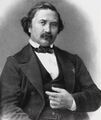Template:Selected anniversaries/March 11: Difference between revisions
No edit summary |
No edit summary |
||
| Line 29: | Line 29: | ||
||1899: Norman Hilberry born ... physicist, best known as the director of the Argonne National Laboratory from 1956 to 1961. In December 1942 he was the man who stood ready with an axe to cut the scram line during the start up of Chicago Pile-1, the world's first nuclear reactor to achieve criticality. Pic. | ||1899: Norman Hilberry born ... physicist, best known as the director of the Argonne National Laboratory from 1956 to 1961. In December 1942 he was the man who stood ready with an axe to cut the scram line during the start up of Chicago Pile-1, the world's first nuclear reactor to achieve criticality. Pic. | ||
||1909: Edmund Louis Gray Zalinski dies ... soldier, military engineer and inventor. He is best known for the development of the pneumatic dynamite torpedo-gun. Pic: https://en.wikipedia.org/wiki/File:Edmund_Zalinski.jpeg | |||
||1915: J. C. R. Licklider born ... computer scientist and psychologist. | ||1915: J. C. R. Licklider born ... computer scientist and psychologist. | ||
| Line 44: | Line 46: | ||
||1944: Edgar Zilsel dies ... historian and philosopher of science, linked to the Vienna Circle. | ||1944: Edgar Zilsel dies ... historian and philosopher of science, linked to the Vienna Circle. | ||
|| | ||1950: Arthur Jeffrey Dempster dies ... physicist and academic. Pic (cool). | ||
File:Philo T Farnsworth.jpg|link=Philo Farnsworth (nonfiction)|1971: Inventor [[Philo Farnsworth (nonfiction)|Philo Farnsworth]] dies. He made many crucial contributions to the early development of all-electronic television. | File:Philo T Farnsworth.jpg|link=Philo Farnsworth (nonfiction)|1971: Inventor [[Philo Farnsworth (nonfiction)|Philo Farnsworth]] dies. He made many crucial contributions to the early development of all-electronic television. | ||
Revision as of 07:52, 13 November 2018
1811: Mathematician and astronomer Urbain Le Verrier born. He will predict the existence and position of Neptune using only mathematics, an event which will be widely regarded as one of the most remarkable moments of 19th century science.
1821: Poet, painter, and printmaker William Blake publishes his award-winning illustrations of demons and angels. A generation later, mathematicians will discover hidden clues to imminent crimes against mathematical constants.
1822: Mathematician, economist, and academic Joseph Louis François Bertrand born. He will work in the fields of number theory, differential geometry, probability theory, economics and thermodynamics.
1823: Publication of Niles Cartouchian and Anton Rhodomunde Confront Gnotilus causes widespread debate about the role of private citizens in fighting crimes against mathematical constants.
1880: American eugenicist and sociologist Harry H. Laughlin born. He will be the Superintendent of the Eugenics Record Office from its inception in 1910 to its closing in 1939, and among the most active individuals in influencing American eugenics policy, especially compulsory sterilization legislation.
1971: Inventor Philo Farnsworth dies. He made many crucial contributions to the early development of all-electronic television.
1996: Engineer and inventor Charles William Oatley dies. He developed of one of the first commercial scanning electron microscopes.
- Rudolph Hell.gif
2002: Inventor and engineer Rudolf Hell dies. He invented the Hellschreiber teleprinter system.
2018: Signed first edition of Red Spiral stolen The State Hermitage Museum in Saint Petersburg, Russia, during a stealthy overnight heist allegedly masterminded by the Forbidden Ratio gang.







